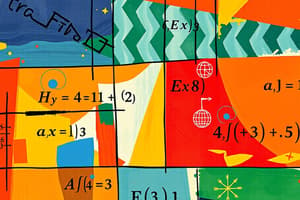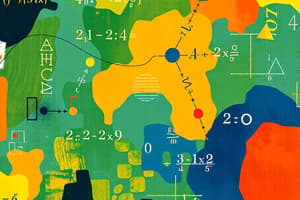Podcast
Questions and Answers
Which statement about inequalities is incorrect?
Which statement about inequalities is incorrect?
- When dividing by a negative number, the inequality sign must be reversed.
- Inequalities can involve expressions that are equal.
- Inequalities can be graphically represented on a number line.
- Inequalities can only be expressed in terms of greater than or less than. (correct)
What is the degree of the polynomial 4x^5 - 2x^4 + 3x^2 - 7?
What is the degree of the polynomial 4x^5 - 2x^4 + 3x^2 - 7?
- 7
- 4
- 2
- 5 (correct)
Which factoring technique is correctly applied to x^2 - 25?
Which factoring technique is correctly applied to x^2 - 25?
- It can be factored as `(x - 5)^2`.
- It can be factored as `(x - 5)(x + 5)`. (correct)
- It can be factored as `x^2 - 5^2`.
- It cannot be factored because it is a prime expression.
In what scenario would you use synthetic division rather than long division for polynomials?
In what scenario would you use synthetic division rather than long division for polynomials?
What is the correct expression for the greatest common factor (GCF) of 6x^3 and 9x^2?
What is the correct expression for the greatest common factor (GCF) of 6x^3 and 9x^2?
How can algebra be applied to solve real-world problems?
How can algebra be applied to solve real-world problems?
Which of the following correctly describes a quadratic function?
Which of the following correctly describes a quadratic function?
How do you isolate the variable in the linear equation $3x + 2 = 11$?
How do you isolate the variable in the linear equation $3x + 2 = 11$?
Which method would NOT typically be used for solving systems of equations?
Which method would NOT typically be used for solving systems of equations?
What is the slope of a line represented by the equation $y = -4x + 2$?
What is the slope of a line represented by the equation $y = -4x + 2$?
What is the first step in factoring the quadratic equation $x^2 + 5x + 6 = 0$?
What is the first step in factoring the quadratic equation $x^2 + 5x + 6 = 0$?
What is the result of simplifying the expression $2x + 3x - 4 + 6$?
What is the result of simplifying the expression $2x + 3x - 4 + 6$?
Which option represents a correct application of the distributive property?
Which option represents a correct application of the distributive property?
What are the x-intercepts of the quadratic function represented by the equation $y = x^2 - 5x + 6$?
What are the x-intercepts of the quadratic function represented by the equation $y = x^2 - 5x + 6$?
Flashcards are hidden until you start studying
Study Notes
Algebra Study Notes
1. Basic Concepts
- Variables: Symbols (usually letters) that represent unknown values.
- Constants: Fixed values that do not change.
- Expressions: Combinations of variables, constants, and operators (e.g.,
3x + 2). - Equations: Statements that two expressions are equal (e.g.,
2x + 3 = 7).
2. Operations
- Addition and Subtraction of Expressions: Combine like terms (e.g.,
3x + 2x = 5x). - Multiplication: Use the distributive property (e.g.,
a(b + c) = ab + ac). - Division: Involves simplifying fractions (e.g.,
x^2/x = x).
3. Solving Equations
- Linear Equations: Solve for x in equations of the form
ax + b = c.- Isolate variable:
x = (c - b)/a.
- Isolate variable:
- Quadratic Equations: Standard form
ax^2 + bx + c = 0.- Factoring, completing the square, or using the quadratic formula:
x = (-b ± √(b²-4ac)) / 2a.
- Factoring, completing the square, or using the quadratic formula:
4. Functions
- Function Definition: A relation that assigns each input exactly one output (e.g.,
f(x) = 2x + 3). - Types of Functions:
- Linear Functions: Graph is a straight line; equation form:
y = mx + b. - Quadratic Functions: Graph is a parabola; standard form:
y = ax^2 + bx + c.
- Linear Functions: Graph is a straight line; equation form:
5. Graphing
- Coordinate System: Consists of x-axis (horizontal) and y-axis (vertical).
- Plotting Points: Points represented as (x, y) pairs.
- Slope: Measure of a line's steepness; calculated as
rise/runorΔy/Δx. - Intercepts: Points where the graph crosses axes; x-intercept (y=0) and y-intercept (x=0).
6. Systems of Equations
- Definition: Set of two or more equations with the same variables.
- Methods of Solving:
- Graphical Method: Plot both equations and find intersection.
- Substitution Method: Solve one equation for a variable and substitute into the other.
- Elimination Method: Add or subtract equations to eliminate one variable.
7. Inequalities
- Definition: A statement that one expression is greater or less than another (e.g.,
x + 3 > 5). - Solving Inequalities:
- Similar to equations but reverse the inequality sign when multiplying/dividing by a negative number.
- Graphical Representation: Shaded regions on number lines or coordinate planes.
8. Polynomials
- Definition: Expressions involving sums of powers of variables (e.g.,
3x^3 + 2x^2 - x + 5). - Degree: Highest power of the variable in the polynomial.
- Operations: Addition, subtraction, multiplication, and division (long division or synthetic division).
9. Factoring
- Factoring Techniques:
- Common Factor: Identify and factor out the greatest common factor (GCF).
- Trinomials: Factor of the form
ax^2 + bx + cinto(px + q)(rx + s). - Difference of Squares:
a^2 - b^2 = (a + b)(a - b).
10. Applications
- Real-World Problems: Use algebra to model and solve problems in various fields such as finance, physics, and engineering.
- Word Problems: Translate real-life situations into algebraic expressions and equations to find solutions.
Basic Concepts
- Variables are symbols, typically letters, representing unknown values.
- Constants are fixed values that remain unchanged in an expression.
- An expression combines variables, constants, and operators, such as
3x + 2. - Equations declare that two expressions are equal (e.g.,
2x + 3 = 7).
Operations
- Addition and subtraction of expressions involve combining like terms (e.g.,
3x + 2x = 5x). - Multiplication utilizes the distributive property, demonstrated as
a(b + c) = ab + ac. - Division requires simplifying fractions, exemplified by
x^2/x = x.
Solving Equations
- Linear equations follow the form
ax + b = c, allowing solutions for x by isolating the variable:x = (c - b)/a. - Quadratic equations are expressed as
ax^2 + bx + c = 0, solvable through factoring, completing the square, or the quadratic formula:x = (-b ± √(b²-4ac)) / 2a.
Functions
- A function assigns exactly one output to each input, represented as
f(x) = 2x + 3. - Linear functions produce a straight line graph, described by the equation
y = mx + b. - Quadratic functions generate a parabolic graph, given in standard form as
y = ax^2 + bx + c.
Graphing
- The coordinate system has an x-axis (horizontal) and y-axis (vertical).
- Points are plotted as (x, y) pairs on this system.
- Slope measures the steepness of a line, calculated as
rise/runorΔy/Δx. - Intercepts are where graphs cross the axes; the x-intercept occurs when y=0, and the y-intercept occurs when x=0.
Systems of Equations
- A system consists of two or more equations sharing the same variables.
- Methods of solving include the graphical method (finding intersection points), substitution method (replacing a variable), and elimination method (adding or subtracting equations to eliminate a variable).
Inequalities
- Inequalities express that one expression is greater or less than another, such as
x + 3 > 5. - When solving, reverse the inequality sign when multiplying or dividing by a negative number.
- Graphical representations involve shaded regions on number lines or in coordinate planes.
Polynomials
- Polynomials are expressions involving sums of variable powers, like
3x^3 + 2x^2 - x + 5. - The degree of a polynomial is determined by its highest power.
- Polynomials can undergo operations including addition, subtraction, multiplication, and division (using long or synthetic division).
Factoring
- Factoring techniques include identifying and pulling out the greatest common factor (GCF).
- Trinomials of the form
ax^2 + bx + ccan be factored into two binomials:(px + q)(rx + s). - The difference of squares is expressed as
a^2 - b^2 = (a + b)(a - b).
Applications
- Algebra is applicable in various fields, such as finance, physics, and engineering, for modeling and solving problems.
- Word problems require translating real-life situations into algebraic expressions and equations for solutions.
Studying That Suits You
Use AI to generate personalized quizzes and flashcards to suit your learning preferences.




